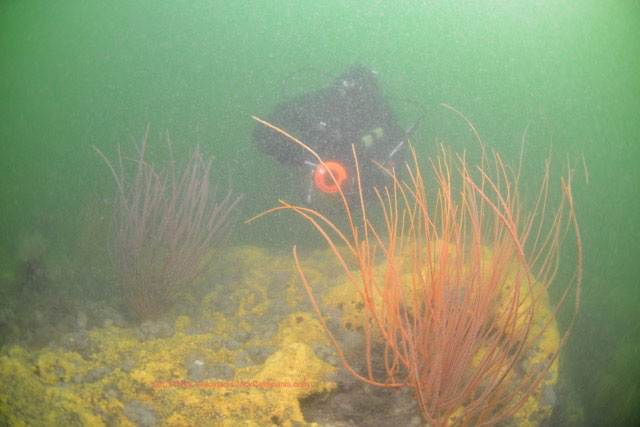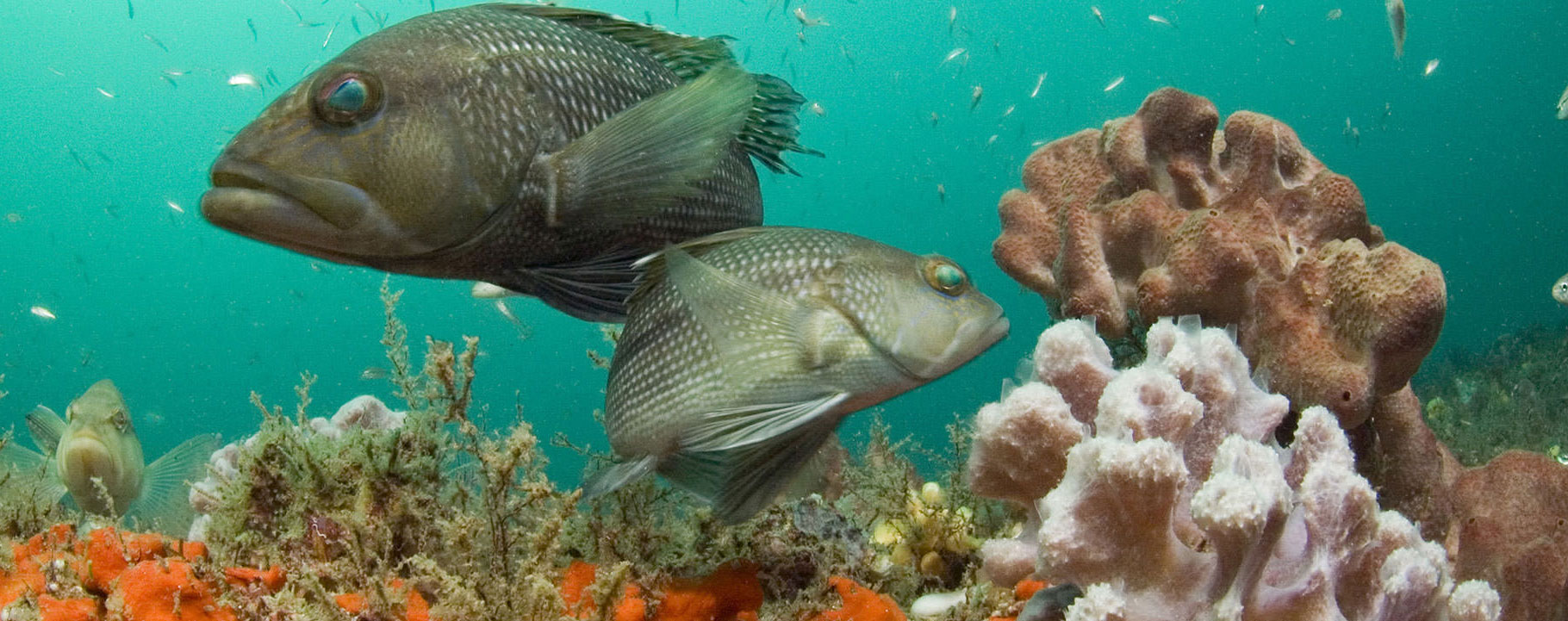When we first dropped a camera to the seabed in 2001 it was because our bottom sampling Ponar Dredge (a small sampling device like a clamshell bucket) was coming up empty—what we called a "water grab." Though marking good bottom and sea bass on my electronics, we often would get no sample with this mechanical device. The underwater camera showed why: rock, many types of rock it would turn out, doesn't sample well by hand. A Ponar grab only works in sand or mud.
Lots of stuff grows on rock, though it doesn't grow at all on sand. Collected together, most folks call this growth "reef". Hiding in between and under rocks and amid the reef growth offers a great way for animals and fish to not get eaten.

Those first camera drops were amazing. No one thought sea whip could form habitat. One of the coast's top ecologists actually laughed at the idea. No one thought we had hard coral. Indeed, no one thought rocky bottom played a role in Mid-Atlantic anything. They still don't! Somehow "important reef habitat" has to be large in human scale. Never mind that most inhabitants are easily held in the hand, sometimes by the dozen.
A very small group of scientists have long understood habitat's importance to fishery restoration efforts. More properly perhaps, they've understood how ignorance of seafloor habitat could retard restoration efforts. One such scientist is Vince Guida from NMFS Sandy Hook Lab, now retired. He was aboard when we dropped that camera. He also did a small sonar survey that found numerous "hard-bottom reef habitats" along the DelMarVa coast near and in the Maryland Wind Energy Area. But the Bureau of Ocean Energy Management (BOEM) must have decided science from NMFS Sandy Hook Lab doesn't count.
In the 2015 "Annual Issue" of Habitat Hotline, published by ASMFC, the BOEM chose 'other' science in their nine-page article on "Public Engagement with BOEM's Processes in the Atlantic". Not Sandy Hook's work, and certainly not mine. Under "Case Study: Report on Benthic Habitats in the Maryland Wind Energy Area," BOEM reports that Maryland Wind Energy Area seafloors, and I quote, "are heavily dominated by mobile sandy bottoms, although small patchy hard-bottom cannot be ruled out." This powerful .guv agency further reports "the most prominent fish encountered was sea robins, however, the report notes that this is not entirely consistent with previous fishery-independent and fishery-dependent trawl data which had far more Atlantic croaker, spot, and weakfish." The old saying, "when you find sea robins, you're near the flounder" apparently just isn't true. (Actually, it is.)
BOEM found no reef and no reef resident fish with trawl surveys. Here, at least, is government consistency—but maybe they should try a camera where their captains are afraid to trawl?
For years I’ve made comments, offered video evidence, and attended multi-day government meetings—pounding on the reefs—with my boat tied to the dock, trying to get our marine reality into focus. Nothing seems to have gotten through. Nothing. Frustrating.
In actuality, Maryland did a thorough job of investigating use. That's how the boxes were drawn. But BOEM is ignoring essential fish habitat in federal waters because there's only one single work on it, Guida's work I mentioned above. It's pretty much true, at the moment, that coral doesn't count north of Georgia.

BOEM seems only interested in types of fish seen for a short while and then gone in a few weeks, which are not reef residents. Atlantic croaker, spot, and weakfish; these transients over open bottom are the only fish that matter to BOEM. Reality: a big heave (storm-driven swells) moves the croakers. Them big croaks stay a few days until the swell dies, then they tighten back up under the beach and mix with the squeakers a bit. Was a handful of trout in with them. So to BOEM's Computer-Driven Reality (and doubtless now our "best available scientific information,") this area is primarily croaker habitat.
Errors, collectively compounding like interest, carry us further and further from needed truths of restoration.
I believe until we understand hard-bottom habitat production's importance to fisheries restoration efforts, we'll continue to spin our wheels in today's regulatory quagmire. We’ll continue losing recreational fishery after fishery while NOAA pats itself on the back before Congress. NOAA gets the intricacies of estuarine life where dams, bay grasses and oysters count, but has only stumbled where the seabed is concerned. And BOEM has turned NOAA's stumble into US Policy.
What's it going to take? An Act of Congress? How about the "Fighting Ignorance in US Fisheries Restoration Policies Act." Or the, "Oh Gee, Maybe Temperate Corals Are Essential Fish Habitat Too Act."
Fishing's being attacked from many angles; BOEM's willful ignorance of obvious fish habitat is only one. But at least it's straightforward. When we can broadly equate reef fish production with actual measures of reef, when an agency can calculate expected fishery production of X species per cubic measure of reef, then discovering how much reef has been lost will also reveal the value of putting it back.
Find out what's missing and put it back.
Here's what's true today: catch estimates that couldn't possibly be correct are in charge. Of course catch must be regulated. However, biology and population ecology must also be brought to bear. Catch restriction has done all it can. Now regulation is killing fisheries like a peyote-driven madness.
For fishing information regarding black sea bass and the Mid-Atlantic reefs and wrecks, read Fishing the Wrecks and Reefs out of Indian River, DE.
Editor’s note: Capt. Hawkins is a driving force behind the Ocean City Reef Foundation, a 501(c)(3) organization which has been building and enhancing reefs off the coast since 1997. If you have ever fished the reef sites out of Ocean City for sea bass, founder, or tautog, you have almost certainly personally benefited from Hawkin’s work. It’s to everyone’s advantage to support the OCRF, so we encourage all serious anglers to make a donation ASAP; go to the OCRF.